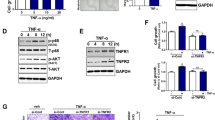Summary
The present study is a detailed kinetic analysis of the synthesis, release and multimerization of fibronectin (FN) in normal and tumor promoter-treated human lung fibroblasts. Pulse/chase and surface labeling experiments were performed to follow the fate of both newly synthesized and pre-existing cell-surface FN over time. The majority of FN (80%) left the intracellular compartment within one hour of synthesis. However, the rate of direct secretion was very low and after one hour, 70% of newly synthesized FN was still at the cell surface. This material was primarily dimeric. Dimeric and multimeric (very high molecular weight) FN was detectable at the cell surface and in the medium 4 hours after synthesis. Pulse-labeled FN multimer levels peaked at 12 hours and declined thereafter. After 24 hours, 85% of pulse-labeled FN had been shed into the medium and the labeled FN remaining at the cell surface was primarily multimeric. Surface labeling experiments confirmed that the majority of FN resides at the cell surface prior to release into the medium.
One hour treatment with the phorbol ester tumor promoter, 12-0-tetradecanoyl phorbol-13-acetate (TPA), stimulated a nine-fold increase in release of preexisting, dimeric cell-surface FN (125I-labeled). The major effect of longer term TPA treatment up to nine hours was continued depletion of dimeric cell-surface FN. Increased release of cell-surface multimeric FN was also stimulated by TPA, but to a much lesser extent. Release of newly synthesized (pulse-labeled) dimeric FN was also stimulated by TPA though much less than pre-existing FN, and TPA treatment produced a small decrease in the steady-state level of multimeric FN. Thus, preexisting cell-surface IN and newly synthesized FN differ dramatically in their susceptibility to TPA treatment.
Similar content being viewed by others
Abbreviations
- FN:
-
fibronectin
- HLF:
-
human lung fibroblasts
- PMSF:
-
phenylmethylsulfonylfluoride
- TPA:
-
12-O-tetradecanoyl phorbol-13-acetate
- DMSO:
-
dimethylsulfoxide
- MEM:
-
minimal essential medium
- ELISA:
-
enzyme linked immunosorbent assay
- PBS:
-
phosphate-buffered saline
- BSA:
-
bovine serum albumin
- SDS-PAGE:
-
sodium dodecylsulfate-polyacrylamide gel electrophoresis
- DOC:
-
deoxycholate
- DTT:
-
dithiotreitol
References
Yamada KM: Cell surface interactions with extracellular materials. Ann Rev Biochem 52: 761–799, 1983
Choi MY, Hynes RO: Biosynthesis and processing of fibronectin in NIL-8 hamster cells. J Biol Chem 254: 12050–12055, 1979
Hynes RO: Integrins: a family of cell surface receptors. Cell 48: 549–554, 1987
McKeown-Longo PJ, Mosher DF: Mechanism of formation of disulfide-bonded multimers of plasma fibronectin in cell layers of cultured human fibroblasts. J Biol Chem 259: 12210–12215, 1984
Blumberg PM, Dreidger DE, Rossow PN: Effect of phorbol ester on a transformationsensitive surface protein of chick fibroblasts. Nature 264: 446–447, 1979
Keski-Oja J, Shoyab M, DeLarco JE, Todaro GJ: Rapid release of fibronectin from human lung fibroblasts by biologically active phorbol esters. Int J Cancer 24: 218–224, 1979
Zerlauth G, Wolf G: Kinetics of fibronectin release from fibroblasts in response to 12-O-tetradecanoyl phorbol-13 acetate and retinoic acid.Carcinogenesis 5: 863–868, 1984
Ruoslahti E, Hayman EG, Pierschbacher M, Engvall E: Fibronectin: Purification, immunochemical Properties and Biological activities. Methods in Enzymology 82: 803–831, 1982
Mosher DF, Vaheri A: Thrombin stimulates the production and release of a major surface-associated glycoprotein (fibronectin) in cultures of human fibroblasts. Exp Cell Res 112: 323–334, 1978
Laemmli UK: Cleavage of structural proteins during assembly of bacteriophage T4. Nature 227: 680–685, 1970
Zerlauth G, Wolf G: Release of fibronectin is linked to tumor promotion: response of promotable and non-promotable clones of a mouse epidermal cell line. Carcinogenesis 6: 73–78, 1985
McKeown-Longo PJ, Mosher DF: Binding of plasma fibronectin to cell layers of human skin fibroblasts. J Cell Biol 97: 466–472, 1983
Collins MKL, Rozengurt E: Binding of phorbol esters to high-affinity sites on fibroblastic cells elicits a mitogenic response. J Cell Physiol 112: 42–50, 1982
Brown PJ: Phorbol ester stimulation of fibronectin-mediated cell adhesion. Biochem Biophys Res Comm 155: 603–607, 1988
Author information
Authors and Affiliations
Rights and permissions
About this article
Cite this article
Burrous, B.A., Wolf, G. The kinetics of fibronectin synthesis and release in normal and tumor promoter-treated human lung fibroblasts. Mol Cell Biochem 96, 57–67 (1990). https://doi.org/10.1007/BF00228453
Received:
Accepted:
Issue Date:
DOI: https://doi.org/10.1007/BF00228453




